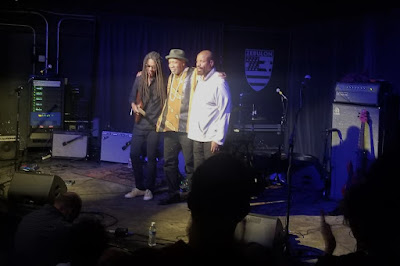Following the great Oceans And, comprised of Aurora Nealand, Hank Roberts and Tim Berne at last week's double bill at Zebulon in the Atwater Village neighborhood of Los Angeles was the phenomenal power trio, Harriet Tubman. The group includes guitarist Brandon Ross, who I knew from his work with Henry Threadgill, starting thirty years ago with the phenomenal Too Much Sugar for a Dime by the Very Very Circus group and on several subsequent albums through the early 2000s; Melvin Gibbs, who stood out to me for his work with the incredible Sonny Sharrock on the Seize the Rainbow album (1987) and the Live in New York recording from two years later; and J.T. Lewis, whom I'd also heard on the Threadgill collective Make a Move (also featuring Ross) 1996 album, Where's Your Cup?
There was a huge contrast between the acoustic and contemplative work of Oceans And, which played one continuous piece during its approximately 50 minute set, and the bracing electric intensity of Harriet Tubman, which flexed its considerable muscle through the powerful work of Lewis cymbal-focused drumming, Gibbs' dexterous and deep bass work, and Ross' pedal-heavy explorations of the guitar. At two points in the show, Gibbs paid homage to two of their most admired influences and favorites of this blogger: Sharrock and the sublime Alice Coltrane.
This band could do it all—nimble jazz, reggae-inspired riddims, the heaviest of metal and far more—and they had many in the audience dancing, headbanging, nodding and demonstrating engagement in all kinds of physical ways, not to mention hearty applause that grew louder as the set progressed. By the time they finished, including a guest appearance by a remarkable vocalist who stepped on the stage from the audience and scatted, screamed, crooned and evoked in many ways, the crowd was roaring with appreciation.
The Terror End of Beauty is the fourth of five Harriet Tubman albums and the 2018 release features several songs rendered at the concert including "The Green Book Blues" and the title track (which evokes Sharrock in composition and Ross' playing), both show highlights. The album captures the range of the band's tonal palette, including contemplative guitar treatments by Ross, the deep-end playing of Gibbs and the solid percussion work by Lewis. It is very well recorded, mixed and engineered and is the product of a band the other recordings of which I definitely need to explore more.
The live show, though, demonstrated that Harriet Tubman is a trio that needs to be experienced live to be fully appreciated as the group takes their studio work and applies a much greater level of power, intensity and drive to move an audience to the types of reactions seen at last week's concert. It would be very interesting to hear the band recorded live and to compare that with the studio work and I would love to see them again!




